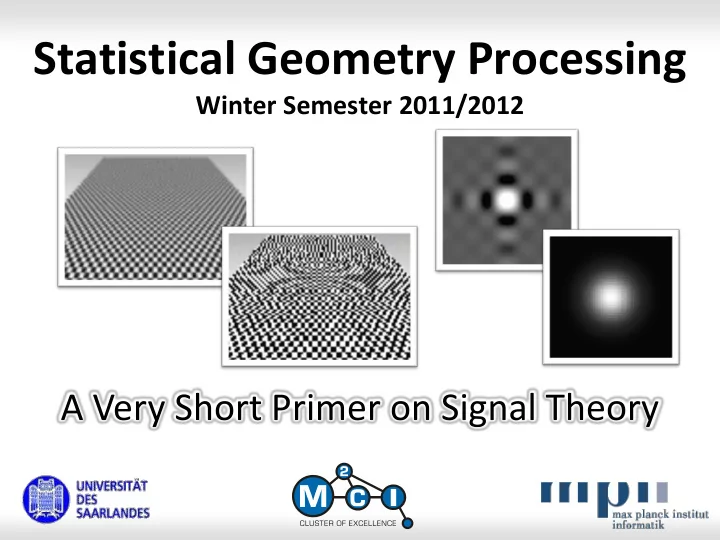

Statistical Geometry Processing Winter Semester 2011/2012 A Very Short Primer on Signal Theory
Topics Topics • Fourier transform • Theorems • Analysis of regularly sampled signals • Irregular sampling 2
Fourier Basis Fourier Basis • Function space: {𝑔: ℝ → ℝ, 𝑔 sufficiently smooth} Fourier basis can represent – Functions of finite variation – Lipchitz-smooth functions • Basis: sine waves of different frequency and phase : Real basis: {sin 2𝜌𝜕𝑦 , cos 2𝜌𝜕𝑦 𝜕 ∈ ℝ Complex variant: {𝑓 −2𝜌𝑗𝜕𝑦 𝜕 ∈ ℝ (Euler‘s formula: 𝑓 𝑗𝑦 = cos 𝑦 + 𝑗 sin 𝑦 ) 3
Fourier Transform Fourier Basis properties: • Fourier basis: {𝑓 −𝑗2𝜌𝜕𝑦 𝜕 ∈ ℝ Orthogonal basis Projection via scalar products Fourier transform • Fourier transform: (f: ℝ → ℂ) → F: ℝ → ℂ ∞ 𝑔 𝑦 𝑓 −2𝜌𝑗𝑦𝜕 𝑒𝑦 𝐺(𝜕) = −∞ • Inverse Fourier transform: F: ℝ → ℂ → (f: ℝ → ℂ) ∞ 𝐺 𝑦 𝑓 2𝜌𝑗𝑦𝜕 𝑒𝑦 𝑔(𝜕) = −∞ 4
Fourier Transform Interpreting the result: • Transforming a real function f: ℝ → ℝ • Result: F 𝜕 : ℝ → ℂ 𝜕 are frequencies (real) Im 𝜕 = 𝑓 −𝑗𝑦 Real input 𝑔 : Symmetric F −𝜕 = F 𝜕 𝜕 ∡𝜕 Output are complex numbers Re – Magnitude: “power spectrum” (frequency content) – Phase: phase spectrum (encodes shifts) 5
Important Functions Some important Fourier-transform pairs box( x ) sinc( 𝜕 ) • Box function: 𝑔 𝑦 = box 𝑦 → 𝐺 𝜕 = sin 𝜕 ≔ sinc 𝜕 𝜕 • Gaussian: 𝑏 ⋅ 𝑓 − 𝜌𝜕 2 𝜌 𝑔 𝑦 = 𝑓 −𝑏𝑦 2 → 𝐺 𝜕 = 𝑏 6
Higher Dimensional FT Multi-dimensional Fourier Basis: • Functions f: ℝ 𝑒 → ℂ • 2D Fourier basis: 𝑔(𝑦, 𝑧) represented as combination of {𝑓 −𝑗2𝜌𝜕 𝑦 𝑦 ⋅ 𝑓 −𝑗2𝜌𝜕 𝑧 𝑧 𝜕 𝑦 , 𝜕 𝑧 ∈ ℝ • In general: all combinations of 1D functions 7
Convolution Convolution: • Weighted average of functions g • Definition: f f ( t ) g ( t ) f ( x ) g ( x t ) dx t Example: 8 / 116 8
Theorems Fourier transform is an isometry: • 𝑔, = 𝐺, 𝐻 • In particular 𝑔 = 𝐺 Convolution theorem: • 𝐺𝑈 𝑔⨂ = 𝐺 ⋅ G • Fourier Transform converts convolution into multiplication All other cases as well: 𝐺𝑈 −1 𝑔 ⋅ = 𝐺⨂G , 𝐺𝑈 𝑔 ⋅ = 𝐺⨂G , 𝐺𝑈 −1 𝐺 ⋅ 𝐻 = 𝐺⨂G Fourier basis diagonalizes shift-invariant linear operators 9
Sampling a Signal Given: • Signal 𝑔: ℝ → ℝ • Store digitally: Sample regularly … 𝑔 0.3 , 𝑔 0.4 , 𝑔 0.5 … • Question: what information is lost? 10
Sampling 11
Regular Sampling Results: Sampling • Band-limited signals can be represented exactly Sampling with frequency 𝜉 𝑡 : Highest frequency in Fourier spectrum ≤ 𝜉 𝑡 /2 • Higher frequencies alias Aliasing artifacts (low-frequency patterns) Cannot be removed after sampling (loss of information) band-limited aliasing 12
Regular Sampling Result: Reconstruction • When reconstructing from discrete samples • Use band-limited basis functions Highest frequency in Fourier spectrum ≤ 𝜉 𝑡 /2 Otherwise: Reconstruction aliasing 13
Regular Sampling Reconstruction Filters • Optimal filter: sinc (no frequencies discarded) • However: Ringing artifacts in spatial domain Not useful for images (better for audio) • Compromise Gaussian filter (most frequently used) There exist better ones, such as Mitchell-Netravalli, Lancos, etc... 2D sinc 2D Gaussian 14
Irregular Sampling Irregular Sampling • No comparable formal theory • However: similar idea Band- limited by “sampling frequency” Sampling frequency = mean sample spacing – Not as clearly defined as in regular grids – May vary locally (adaptive sampling) • Aliasing Random sampling creates noise as aliasing artifacts Evenly distributed sample concentrate noise in higher frequency bands in comparison to purely random sampling 15
Consequences for our applications When designing bases for function spaces • Use band-limited functions • Typical scenario: Regular grid with spacing 𝜏 Grid points 𝐡 𝑗 Use functions: exp − 𝐲−𝐡 𝑗 2 𝜏 2 • Irregular sampling: Same idea Use estimated sample spacing instead of grid width Set 𝜏 to average sample spacing to neighbors 16
Recommend
More recommend